Blackwater — cute or scary?
Friday, December 17th, 2010[ by Charles Cameron ]
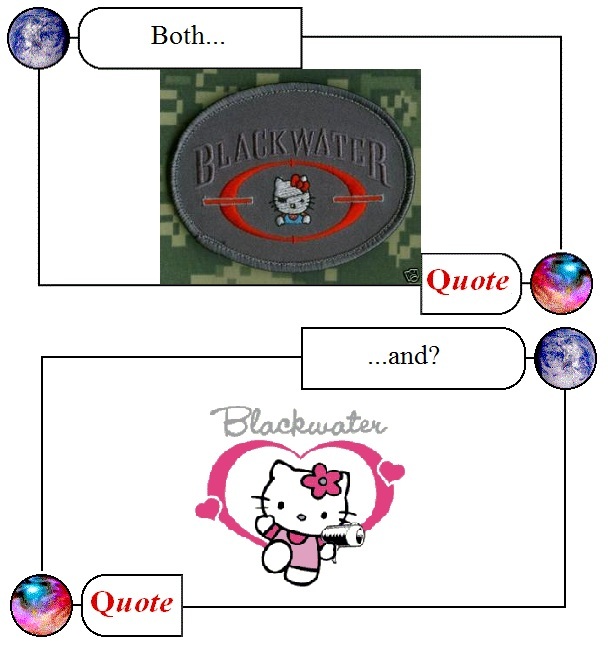
This DoubleQuote was prompted by Spencer Ackerman, writing on Danger Room today: Will Blackwater Go Vegan After Sale to Hippy Firm?
[ by Charles Cameron ]

This DoubleQuote was prompted by Spencer Ackerman, writing on Danger Room today: Will Blackwater Go Vegan After Sale to Hippy Firm?
[ by Charles Cameron ]
We’ve been having an intriguing discussion recently in the comments here on Zenpundit about mapping / modeling complex situations in a way that leaves us humans more liable to come to nuanced understandings and less liable to unintended consequences, and one point that keeps on cropping up is the need to pare down the number of nodes in our mapping without losing sight of the subtleties…
I was thus delighted to find, as I was doing my morning trawl of usual and unusual news sources, that Glenn Beck had come out with his estimate of how many Muslim terrorists there are in the world (10% of the global Muslim population, ie 157 million), Fareed Zakaria had refuted him — and there was even a helpful Silobreaker network diagram to show me how the relevant nodes under discussion fit together:
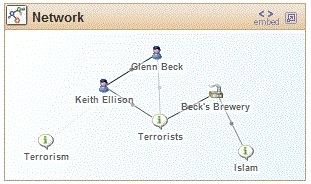
I was delighted to see that (Mormon) Glenn Beck is more closely associated with (Muslim) Rep. Keith Ellison than he is with terrorists, and sorry to note that Beck’s Brewery and Islam are somehow linked… But naturally, once I had seen this much I wanted to drill down even deeper — so I entered the appropriate keywords at Silobreaker and found this:
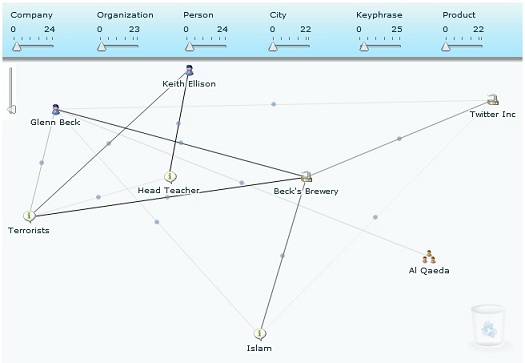
You’ll see that Beck’s link with Al Qaeda is, thankfully, a weak one. And I think you’ll agree with me that even shifting from a six node to an eight node graph considerably ups the sophistication of analysis required to fully comprehend the issues portrayed.
*
In any case, I thought it might be appropriate to post Silobuster’s more detailed map of the current situation with WikiLeaks here:
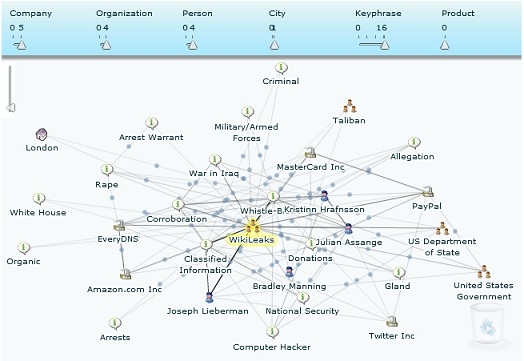
All becomes clear, eh?
I particularly like the node labeled “Gland” (it’s almost hidden but not quite, you’ll find it lower right, between PayPal and Twitter)– that might be the one I’d zero in on to get a fuller appreciation of the complexities of the situation.
And for the record, this post is an example of British “humor” — or as we prefer to call it, “dry wit”.
by Charles Cameron
[ cross-posted from ChicagoBoyz ]
I’ve been thinking…
*
Reports, overstatements and underestimates
There are factual reports of violence and threats of violence, which are within the proper province of journalism and intelligence gathering.
There are also overstatements of such reports, generally resulting from paranoia, hatred, recruitment, or the desire to increase sales of advertising or munitions.
And there are understatements of such reports, generally resulting from sheer ignorance or a desire to be diplomatic.
*
Religious sanctions for violence
Similarly, there are factual reports of sanctions for violence in the scriptures, hagiographies and histories of various religions.
There are also overstatements of such reports, attributing to entire religions the beliefs and or activities of a significant subsection or outlier group of that religion
And there are understatements of such reports, avoiding the attribution of violence to religious beliefs regardless of whether the religious correlation is a “cover” for other motives or a sanction powerfully affecting the actions of those who respond to it.
*
Proportional and disproportionate responses
There are actions which represent a balanced and proportional response to threats or acts of violence, whether they be made at home or abroad, by the military or law enforcement, for reasons of just war or of security.
There are actions which present an unbalanced and disproportionate heightened response to acts of violence, into which category I would place both over-reactive military responses and over-reactive domestic security measures.
And there are inactions which are no less unbalanced as responses to acts or threats of violence, as with political wool-gathering or appeasement, bureaucratic failures to implement realistic information sharing and dot-connection within the IC, or public aversion to factual news or intelligent, nuanced analysis.
*
Ideals, kumbaya and skepticism
There are honest statements of aspiration for peaceable outcomes to current and future conflicts.
There are versions of such aspirations which naively overlook the very real correlations between religious sanctions and violence.
And there are skeptical aversions to such aspirations, which no less naively overlook the very real differences which are present between the most angry, the most terrified, the most politically driven, the most financially interested and the most generous members of any and every religious and irreligious viewpoint.
*
Let’s talk…
It is useful to bear these distinctions of category in mind, and to make accurate appraisals of one’s information inputs in terms of which categories they fall under, and how much trust one should therefore place in them.
There: it was on my mind and I have said it.
This is, as my title indicates, a first draft. I hope it will spark some interesting conversations, and lead to further insight and refinement…
Charles Cameron is the regular guest-blogger at Zenpundit, and has also posted at Small Wars Journal, All Things Counterterrorism, for the Chicago Boyz Afghanistan 2050 roundtable and elsewhere. Charles read Theology at Christ Church, Oxford, under AE Harvey, and was at one time a Principal Researcher with Boston University’s Center for Millennial Studies and the Senior Analyst with the Arlington Institute:
The United States of Islam Video
by Charles Cameron
[ the first in a series, cross-posted from Chicago Boyz ]
Let’s take a closer look at the United States of Islam video which I mentioned in my post Of Weaponry and Flags.
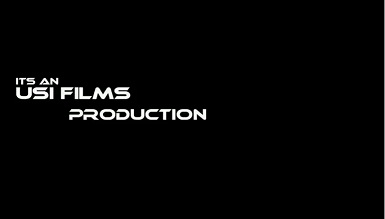
The video announces itself as “an USI Films production”. It then opens with the words “since 911 the world has changed” in white type against black, followed immediately by news clips of the WTC attacks and of President Bush describing them as “evil acts” and declaring “I have directed the full resources of our intelligence and law enforcement communities to find those responsible, and to bring them to justice.” What we shall be seeing, then, is a time-oriented video, presenting a historical context for the present moment with implications for the near future. From here we cut by way of another white on black typed message — “they started this war in afghanistan” – via clips of war footage to another – “but their agenda is much bigger and brutal than that” – and then to another clip of Pres. Bush: “Our war on terror begins with al-Qaida but it does not end there. It will not end until every terrorist group of global reach has been found, stopped, and defeated.” By this point, the background music, which is taken (for reasons both political and musical?) from Vangelis’ 1492 – Conquest of Paradise soundtrack, is swelling. A global map appears, showing much of north Africa, the middle east, Indonesia and Malaysia in green, with Pres. Bush in voice over speaking of the establishment of “a violent political utopia across the middle east which they call a Caliphate where all will be ruled according to their hateful ideology.”
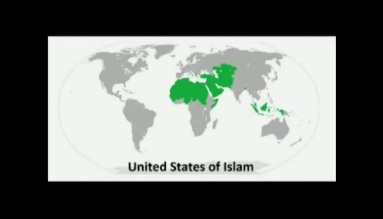
The map is titled United States of Islam. The words “they have done this before” are then followed by a series of film clips showing “the fall of the Khilafa 1828 -1924” and maps showing the slow spread of the British and French flags across north Africa and the middle east, with glimpses of Lawrence of Arabia, the Balfour declaration, and General Allenby, accompanied by the voice-over of someone I’d tentatively identify as Sheikh Imran Nazar Hosein, declaring: The Khilafa was destroyed. Who destroyed it? Why did they destroy it? How did they destroy it? When did they destroy it? What did they replace it with? With what was it replaced? And what is its destiny?
These are awesomely important questions which very few can answer today.
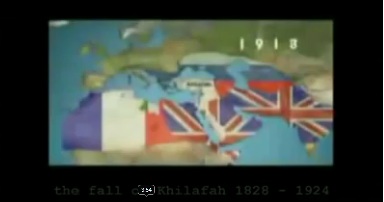
The text then states that (the west) “divided us into 54 states” and the map begins to show the various flags of the Islamic states intowhich the region was more recently divided…
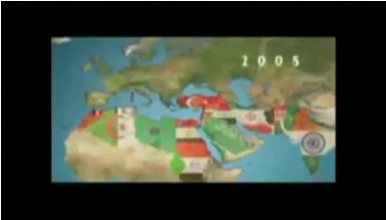
ending up in 2006. And what do we want now? You might be forgiven if you haven’t already guessed:
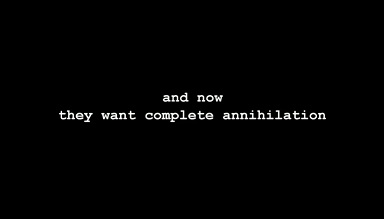
Clips then show the toppling of Saddam’s statue in Baghdad, the Israeli army in Gaza with casualties, the October 2009 Pishin attack on the Revolutionary Guard in Iran (which was claimed by Jundullah), and a first mention of the Christmas bomber, Al Qaida and Yemen… a quick mention of Nigeria and Somalia… and “Pakistan from which they fear the most”. A newscaster from, presumably, Pakistan intones “this is called the fourth generation warfare.” That essentially brings us up to the present moment. * We have arrived at the half way point in the 10 minute video and seen the global historical context, laid out in maps and flags. We have focused in on the present from a two-hundred year sweep, and on Pakistan from the distributed ummah. What follows will expound and expand on this present moment, bringing Afghanistan into the picture alongside Pakistan, emphasizing the spiritual significance of Khorasan, and taking the battle variously to India and Jerusalem…
[ to be continued ]
WARNING: RANT AHEAD!
NYT Columnist David Brooks (via Metamodern):
….Burney’s struggle reminds one that character is not only moral, it is also mental. Heroism exists not only on the battlefield or in public but also inside the head, in the ability to face unpleasant thoughts.
She lived at a time when people were more conscious of the fallen nature of men and women. People were held to be inherently sinful, and to be a decent person one had to struggle against one’s weakness.
In the mental sphere, this meant conquering mental laziness with arduous and sometimes numbingly boring lessons. It meant conquering frivolity by sitting through earnest sermons and speeches. It meant conquering self- approval by staring straight at what was painful.
This emphasis on mental character lasted for a time, but it has abated. There’s less talk of sin and frailty these days. Capitalism has also undermined this ethos. In the media competition for eyeballs, everyone is rewarded for producing enjoyable and affirming content. Output is measured by ratings and page views, so much of the media, and even the academy, is more geared toward pleasuring consumers, not putting them on some arduous character-building regime.
In this atmosphere, we’re all less conscious of our severe mental shortcomings and less inclined to be skeptical of our own opinions. Occasionally you surf around the Web and find someone who takes mental limitations seriously. For example, Charlie Munger of Berkshire Hathaway once gave a speech called “The Psychology of Human Misjudgment.” He and others list our natural weaknesses: We have confirmation bias; we pick out evidence that supports our views. We are cognitive misers; we try to think as little as possible. We are herd thinkers and conform our perceptions to fit in with the group.
But, in general, the culture places less emphasis on the need to struggle against one’s own mental feebleness. Today’s culture is better in most ways, but in this way it is worse
True, and kudos to David Brooks for calling attention to the deficit in metacognition. However, I suspect that there is more to this phenomena than decadence, ADHD and a handy internet connection. There’s a problem with our epistemology. To be specific, a common epistemological standard is fading from American life, giving license to demagogues and emboldening fools.
There are many possible causes. The decline of critical thinking, logic, history and science in the curricular standards of American public schools; the disappearance of liberal education and the excesses of postmodernism, deconstructionism, constructivism and crit theory in our universities; the dumbing down of the MSM into 7 second sound bite infotainment and partisan agitprop; political correctness and its fetishes of race and gender victimization and witch-hunting; the growing legitimization of magical thinking inherent in religious fundamentalism and secular equivalents in irrationality like “deep ecology” or crackpot conspiracy theories. All of these and more have combined to erode standards of public discourse to an ever lower common denominator.
John Adams once argued before a Massachusetts jury that “facts are stubborn things”. Today it is unlikely that such an appeal would work. Not only do many people believe that they are entitled to their own set of “facts” but that they can, if they wish, dispense with facts entirely, yet self-righteously insist that their deliberate ignorance should be given the same weight as an informed argument because they “have a right to their opinion” without anyone daring to ask them why they are so morally and intellectually retarded.
Where once intellectual embarrassment prevented outright lies or inane arguments from being made in respectable forums, the popular deference to the dignity of cranks puts tin-foil hatters and their OCD political convictions about Bush orchestrating 9/11 or Obama being a secret Muslim in the center of public debate instead being confined to off-center mimeographed pamphlets passed out at airports by glassy-eyed true-believers. We feel compelled as a society to politely entertain drivel that should never have been heard past a kitchen table with a three quarters empty bottle of whiskey on it.
The country needs to regain a common intellectual ground that eschews nonsense for what it is.